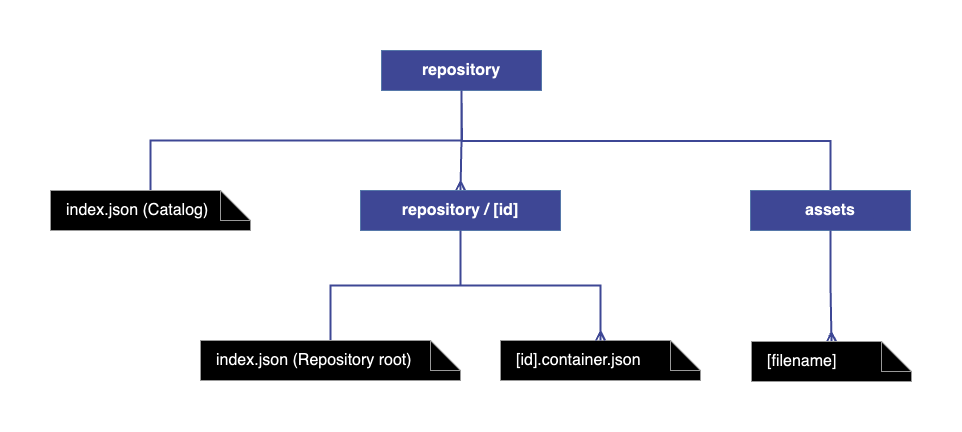Introduction
TIP
For those new to Tailor, it's recommended to familiarize yourself with foundational concepts such as Repository, Activity or Content Container by exploring the Concepts section.
For those more interested in retrieving published entities rather than the format of published content, consider exploring the Garment library. Note that a flat repository structure is required for its use (see below).
Storage root
When content is published using Tailor, it's stored in the configured storage solution of your choice. Currently, Tailor supports adapters for local storage and AWS S3. Publishing content makes is ready for application ingestion and delivery.
Here's how Tailor organizes content in the storage:
repositorydirectory is created in the storage root.repository/index.jsonfile, known as the catalog, is created to provide an overview of all published repositories.repository/[id]directory is created for each published content repository, named by its unique id.repository/assetsdirectory is created for static asset storage (e.g. images). This is because assets might be reused across different repositories.
Published Repository structure
The published repository consists of two main file types:
Repository Manifest File (
index.json): Located atrepository/[id]/index.json, this single file contains general information about the repository and outlines the repository structure. It includes details on the activities that define the structure of the repository.Content Container Files (
[id].container.json): There are multiple content container files, named[id].container.json, whereidcorresponds to the published content containers primary key. These files contain the specific content and metadata for each container.
TIP
For additional information on these file types, refer to the dedicated documentation pages.
When publishing repositories, there are two options for structuring the published content within the repository/[id] directory:
- Flat Repository Structure
- Nested Repository Structure (deprecated)
Flat Structure
To enable the flat repository structure, the environment variable FLAT_REPO_STRUCTURE=true must be set. This structure, which is now the default, consolidates all published containers within the repository/[id] folder.

Consider simple Repository schema defined as:
const SCHEMA = {
id: 'PAGE_COLLECTION',
name: 'Page collection',
structure: [
{
type: 'PAGE',
label: 'Page',
color: '#08A9AD',
contentContainers: ['SECTION'],
},
],
contentContainers: [
{
type: 'SECTION',
templateId: 'DEFAULT',
label: 'Section',
},
],
};When a Repository is created and assigned an id (for example, id 1), and it includes activities such as Page 1, Page 2, and Page 3, each containing a single Section container (with ids 4, 5, 6 respectively), the publication of the entire repository results in the following structure:
repository/index.json: Contains general information about the repository, such as its id, name, description, and the date it was last published.repository/1directory contains:index.jsonRepository root file which contains information about the repository including the list with all of the Pages (without Section content).- Contains all the published Section containers:
4.container.json,5.container.json,6.container.json.
Nested Structure
In contrast, the nested structure (which is now deprecated) organizes content differently. Each structural activity, such as Page 1, Page 2, and Page 3 (assigned ids 1, 2, 3 respectively), would have its content container stored within a specific [activity_id] folder inside the [content_repository_id] folder. This means the containers would be located at:
repository/1/1/4.container.jsonfor Page 1,repository/1/2/5.container.jsonfor Page 2,repository/1/3/6.container.jsonfor Page 3.
